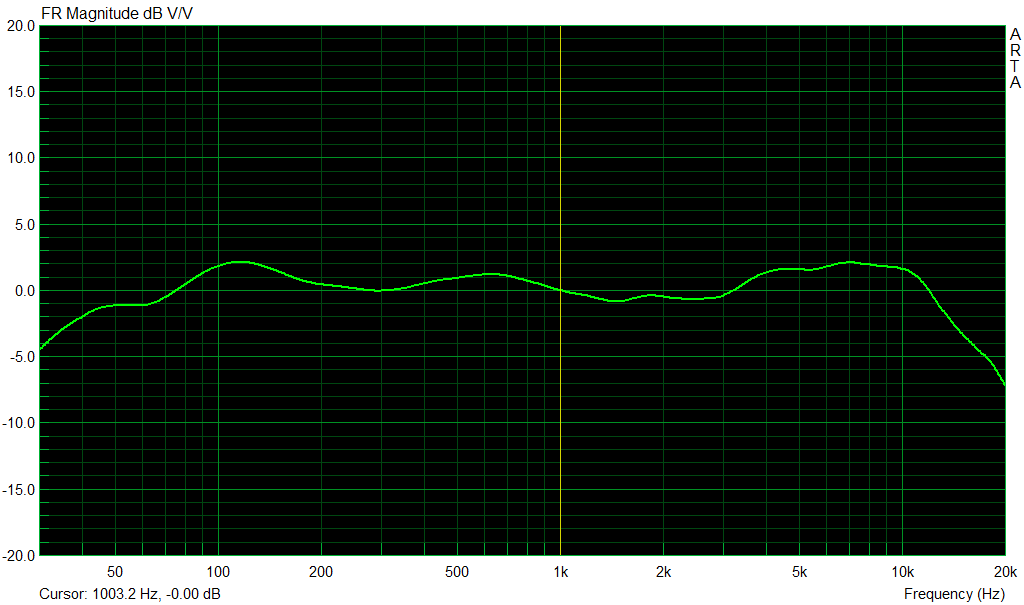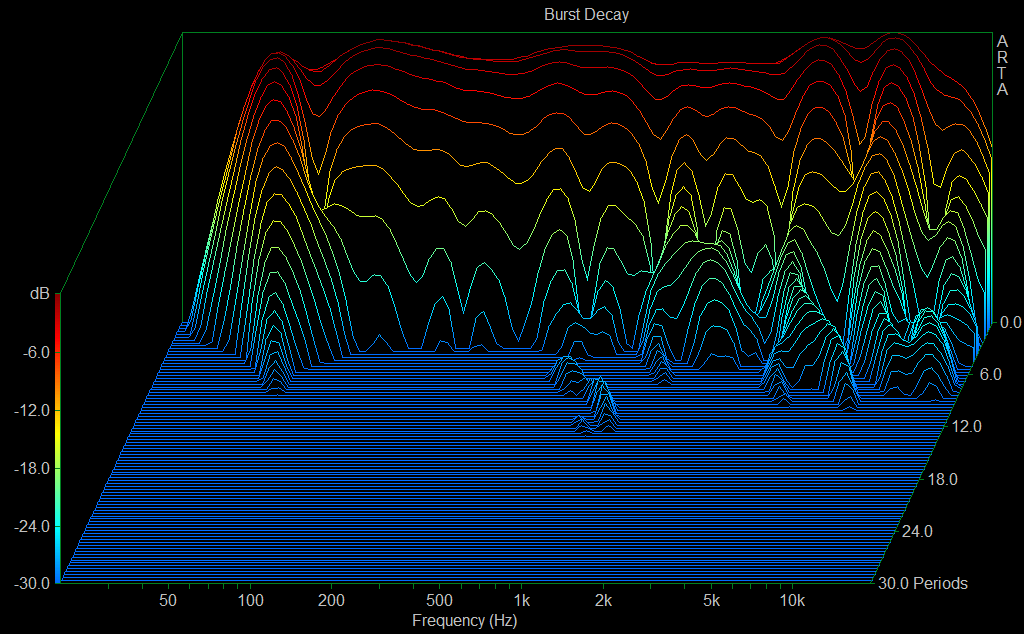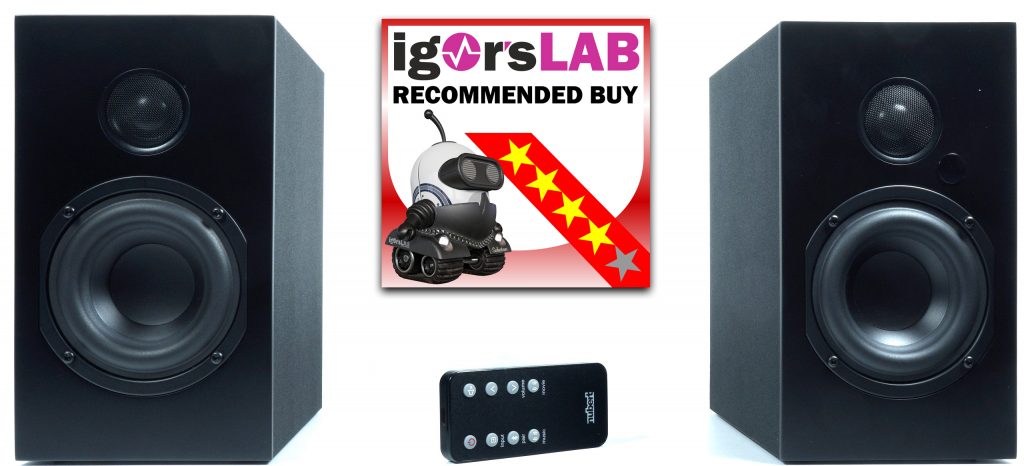Frequency range and course
The measured frequency curve is good and not even a bathtub if you let the boxes play neutrally without DSP intervention. From the factory, however, a slight height and bass increase is possible. We see a slight increase in approx. 120 Hz and above from approx. 3 KHz a slightly rising level. We can speak here of a very small range of tolerance. The drop in height in the super high tone also results from the performance of the very direction-dependent drivers and does not appear as pronounced or almost measurable in the near field. Nevertheless, the alignment of the boxes is also immensely important on the desktop.
Cumulative Spectra
The cumulative spectrum denotes different types of diagrams that show time-frequency properties of the signal. They are generated by successive application of the Fourier transformation and suitable windows to overlapping signal blocks. These analyses are based on the frequency response diagram already shown above, but also contain the element time and now show as a 3D graphic ("waterfall") very clearly how the frequency response develops over time after the input signal stopped. In colloquial terms, such a thing is also called "end" or "swingout".
Normally, the driver should also stop as fast as possible after the input signal has been dropped. However, some frequencies (or even entire frequency ranges) will always subside slowly and then continue to appear in this chart as longer-lasting frequencies on the time or period axis. This is a good way to see where the driver has glaring weaknesses, perhaps even "squealing" or where, in the worst case, resonances may occur and disturb the overall picture.
With the NOW no longer common CSD, the plot is generated in the time range (ms), while the burst decay plot used here is displayed in cycles. And while both methods have their advantages and disadvantages (or limitations), it can be said that the display in periods may be more useful to determine the decay of a loudspeaker with a wide bandwidth. And that's where the A-125 scan really well.
We see a slight resonance vibration in the upper bass at approx. 100 Hz, a few small trailers between 1 and 2 kHz and later also from approx. 5 kHz upwards. But this is not something that is subjectively perceived as negative. Ergo sounds dust-dry, which should clearly be understood as a compliment.
Let us now come to the subjective assessment of things and simply leave the measurement curves to the left. The assessment is based on the normal setting with disactivated DSP games. And for all the curious: the system ran in the continuous loop for almost 72 hours before the measurement.
Bass
Test the lowest bass in the subcontraoctave (16.4 Hz to 32.7 Hz) with a recording of Bach's Toccata and Fugue in D minor (19 and 25 Hz) and the Festival Overture 1812 by Tchaikovsky (10 Hz and 12.5 Hz). The same applies to the lower ranges of the contraoctothe (32.7 to 65.4 Hz). The big bass drum (kick drum), which in the U-music is a welcome companion and usually on approx. 55 to 60 Hz, this assessment will then be rounded off.
The bass is a little more restrained from about 70 Hz downwards, but still has plenty and above all a refreshing clarity and differentiation. From approx. 50 Hz it then becomes a little thinner downwards, and the sub-contraoktave then becomes much weaker until its complete non-existence. Here you have to help with a subwoofer, if it is to go down to the black ravens in the cellar. For the large bass drum of conventional U-music, however, it is still easy enough. The character is rather dry, but what pleases.
The upper bass up to 150 Hz, in which also the Great Octave (65.4 to 130.8 Hz) is located, houses the basic language frequency of the male voice and decides very strongly on the true-to-life reproduction of male vocals.
This area sounds really good, because the mouse does not bite off a thread. The male vocals are very full, but still quite dry, the instruments are hardly distorted. Overall, the resolution is astonishingly high and lets orchestral pieces, rock, pop and jazz of all stripes perform well to very well. However, the installation location should be chosen carefully if you want to bypass annoying fashions, because the resonance frequency of the small box is quite high.
Frequency range
The lower middles (also basic tone range) are approx. 150 to 400 Hz. Together with the already mentioned upper bass, this area plays a very important role for the subjectively perceived heat or bass. Fullness of the sound. The basic language frequency of female voices can be found in this area.
Here, too, there is no reason to criticise, nothing is shaking or sticking, on the contrary, everything remains dust-dry as before. Female vocals can shine and get to the point. The timbre of the voices and recorded instruments is almost neutral, but never too cold or even analytical. The further course upwards is also free from any criticism. The precision is above average and makes the system a good all-rounder for work and fun.
The upper mids between 400 Hz and about two KHz contain a mark at a KHz, which is still considered a reference for many measurements. Unfortunately, this is often noticeable with cheaper devices, as manufacturers often try to overemphasize this frequency. This area does not play an insignificant role in gaming either, and balanced playback contributes significantly to good spatial resolution.
The stage and the subjectively perceived quality of the spatial resolution is at a very high level, which in the end also justifies the price. An orchestra appears (purely subjectively) far enough and precisely positioned, which makes it possible to locate individual instruments quite clearly and unambiguously at different overall levels. Speech playback is also not lost in this area, no matter how many sources are mixed. The suitability on the desktop is underlined by the very good spatial image in games with excellent audio material.
High-pitched range
Between two and about 3.5 KHz, human hearing is most sensitive, especially since this area of the lower heights is responsible for the good overtone reproduction of the human voice. This frequency range is crucial for the recognition of a voice or instrument; in this context, one also speaks of the respective timbre.
The playback here is also free of criticism and the speech intelligibility as well as the quality of the vocals can definitely convince. It is also good that the active crossover has been tuned in such a way that there is no audible overemphasis or level drop. The transition between the two chassis is pleasantly flowing and, above all, one thing above all: actually not perceptible. But you will pay attention to the ideal installation location and, if necessary, you will be able to place it. first have to search, because the small calottes without a large waveguide are very direction-dependent. If you put the boxes far apart, you should turn them correctly in the direction of the listening position, it is worth it.
The middle heights (3.5 to six KHz) decide on the sound or failure of the speech reproduction as a whole, because the S- and hissing (Sibilants) fall into this range. The upper heights then reach up to approx. ten KHz to move into the super high tone.
High and super high tone are very good, even if the boxes are a bit too agile, especially the higher it goes. Sibilants and breathing sounds are accurately depicted, but not extremely overstressed or swallowed. It never sounds too pointed or even metallic, but still natural. String edible instruments are also not washed forward or into the orcus and rather filigree strings are not degraded to dull recorders. A drum remains one, right down to the softly painted jazz brooms, which can really go under the skin.
Summary and conclusion
Almost 400 euros for a pair of near-field monitors is certainly a proud price, but it quickly relativizes when you look at the size. The Klipsch R-15PM were already borderline due to the very large monitor due to the very large monitor and every centimeter saved is just good. If you compare the whole thing with good near-field entry-level models like an Adam T7V or a Yamaha HS7, you can get away with a bit cheaper or at least the same price, but saves significantly in space. I don't need XLR on the monitors, but I still have a mixer and preamplifier anyway if necessary, but I get the desired optical input for the connection to the PC and for the fun also a little Bluetooth with sub-out for the bottom.
To get us to understand each other correctly – specialized near-field monitors have undeniably their advantages and are even significantly cheaper in places, but Nubert succeeds with the NUBOX A-125 a refreshing compromise of acoustically usable workplace placement, nice entertainment and enormous space savings. The whole thing coupled with a really flawless implementation and a very high processing quality is then almost a must-have. For the desktop, the bidding is easy enough, for rooms up to approx. 20 m2 for sure. Beyond that, however, there is something missing from the punch.
The movie mode is definitely not recommended for music playback, but all the more so if you want to play or watch a movie. Together with a potent subwoofer, you don't need a 5.1 swearing system for the impressive immersion, so the mail goes off. The mix does it in this case, not the specialization. It could have been a little more output power and I would also like a hinted waveguide for the tweeter, because the small calotte sits quite deep in the case. But there is nothing else to complain about.
Link to the product on the manufacturer's page




































Kommentieren